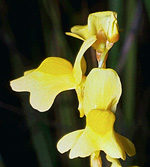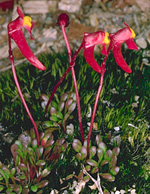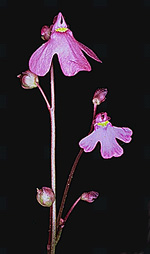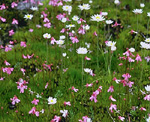 |
This small family is almost cosmopolitan, mostly in warm, moist regions. In Australia, members of the 2 genera may be found almost anywhere except the arid centre, in moist, usually sandy, nitrogen-deficient soils in open habitats. A few species are aquatic.
Characteristic features of the family Lentibulariaceae in Australia include: - small, delicate, carnivorous herbs growing in moist soil, or free-floating submerged aquatics with only the flowers emergent
- leaves often very small, entire or much-dissected (or both types of leaves present on the one plant), some leaves bearing small bladder-traps which capture minute animals when triggered by movement
- flowers showy, blue, red or yellow, strongly zygomorphic with a 2-lipped or 1-lipped, often spurred corolla
- stamens 2, inserted at the base of the short corolla tube
- ovary superior with a more or less sessile, 2-lobed stigma, developing into a capsule
Description
Annual or perennial terrestrial herbs, or rarely herbaceous vines climbing by twining stems, or rarely aquatic herbs either free-floating with their leaves submerged, or rooted in the substrate with their leaves submerged, floating or emergent. Perennating by taproots or crowns. Vegetative reproduction absent or by stolons. Plants carnivorous, using submerged or underground bladders. Stem internodes solid or hollow. Internal secretions not obvious. Plants glabrous, or with simple, glandular or non-glandular, unicellular or uniseriate hairs. Leaves distichous, opposite, or in whorls of 3–7 or more, all or mostly basal or mostly cauline, or both basal and cauline, petiolate, subsessile or sessile. Stipules absent. Lamina simple, symmetric or conspicuously asymmetric, pinnatifid, pinnatisect, bipinnatifid or tripinnatifid, etc, filiform, acicular, subulate, linear, oblanceolate or obovate; base cuneate or attenuate; margins entire or spiny, ±flat; one-veined, or the venation pinnate, with the midrib inconspicuous, and the tertiary venation not reticulate; surfaces not punctate; herbaceous, membranous or papery. All the flowers bisexual. Inflorescences terminal or leaf opposed, consisting of racemes, verticillasters or solitary flowers. Bracts present. Bracteoles present or absent. Pollination by insects. Flowers odourless or fragrant, stalked. Floral disc absent; nectaries present on the perianth. Perianth irregular, of 2 dissimilar whorls, imbricate in bud. Calyx segments free or fused, with 2 or 4 sepals or lobes; calyx bell-shaped, herbaceous. Corolla segments fused, with 5 petals or lobes, alternating with the sepals or calyx lobes; corolla 2-lipped, sometimes with a palate, white, cream, yellow, orange, red, pink, magenta, purple, violet, grey, brown or black, without contrasting markings, or streaked, spotted, etc, membranous; base spurred. Fertile stamens 2, opposite to the sepals or calyx lobes, free of the corolla, free of the ovary and style, fused by their filaments into an open or closed tube, all ±equal. Anthers basifixed, not versatile, opening inwards by longitudinal slits, 2-celled. Ovary superior and sessile. Carpels 1–2, fused; ovary with 1 locule. Style terminal, absent or single and unbranched, or branched above, capitate or lobed. Ovules 2–numerous, sessile; placentation free-central. Fruit a dry or fleshy, dehiscent valvular, circumscissile or operculate capsule; the perianth on the maturing fruit deciduous, dry and persistent or growing larger. Disseminule macro-surface featureless or winged; micro-surface ±papillate, alveolate or reticulate, brown, dull. Seeds 2–numerous per fruit. Aril absent. Cotyledons 0. Embryo straight.
(Note: this description has been generated from the coded data compiled for the key. Any errors in the key data will be reflected in the descriptions.)
A treatment of the family Lentibulariaceae has not yet been published in the Flora of Australia. It will appear in Volume 33.
Australian genera of Lentibulariaceae (as recognised for the Flora of Australia)
Polypompholyx
Utricularia

|
  |

Utricularia chrysantha (flowers)
Photo: G.Butler © ANBG

Utricularia menziesii (flowering plant)
Photo: M.Fagg © ANBG

Utricularia multifida (flowers)
Photo: M.Fagg © M.Fagg

Utricularia multifida (habit)
Photo: P.Ollerenshaw © ANBG

|

| |